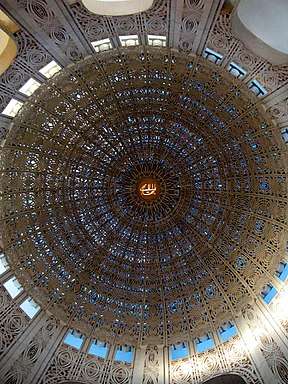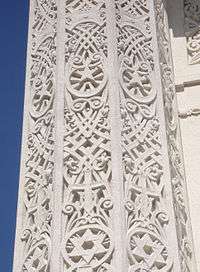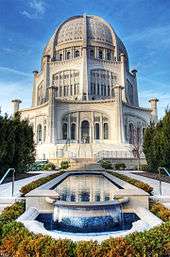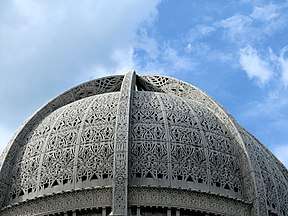Bahá'í House of Worship (Wilmette, Illinois)
|
Bahá'í Temple | |
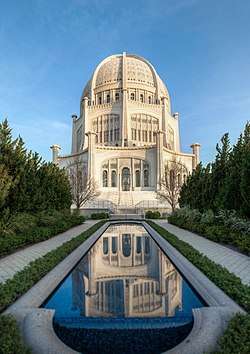 | |
  | |
| Location | 100 Linden Ave., Wilmette, Illinois |
|---|---|
| Coordinates | 42°4′27″N 87°41′3″W / 42.07417°N 87.68417°WCoordinates: 42°4′27″N 87°41′3″W / 42.07417°N 87.68417°W |
| Area | 6.97 acres (2.82 ha) |
| Built | 1912-1953 |
| Architect |
Louis Bourgeois George A. Fuller |
| Website |
www |
| NRHP reference # | 78001140[1] |
| Added to NRHP | May 23, 1978 |
The Bahá'í House of Worship (or Bahá'í Temple) is a temple in Wilmette, Illinois. One of ten dedicated temples of the Bahá'í Faith, it is the oldest surviving Bahá'í House of Worship in the world.[2]
History
Early plans
In 1903, a small group of Bahá'ís in downtown Chicago first discussed the idea of a Bahá'í House of Worship in the Chicago area. At the time, the world's first House of Worship was being built in Ashgabat, what is now Turkmenistan.[3] The Ioas family was particularly involved in the first requests.[4] A Bahá'í from Chicago named Corinne Knight True went on pilgrimage to British Mandated Palestine in 1907 to visit `Abdu'l-Bahá, then leader of the religion, and tell him of the growing interest in a local house of worship. During Thornton Chase's pilgrimage, he had asked `Abdu'l-Bahá about it as well and was directed to work with True as "complete directions" had been given to her.[5] A series of newspaper articles in the fall of 1908 including Chase among a set of women in several newspapers about the aim of the Bahá'ís to build it.[6] This interaction led to the next development of a national sense of community: The election of the first national council of the religion, with delegates present from across the US and Canada, in the spring of 1909.[5] Thirty percent of the members elected were women. `Abdu'l-Bahá gave his blessing to the project, but recommended that the structure be built away from the Chicago business district, in a more quiet area near Lake Michigan.[7] The Bahá'ís considered building the temple in Chicago's Jackson Park or the suburb of Evanston,[8] but eventually settled on Wilmette, Illinois, just north of Evanston. True began coordinating work and acted as the treasurer of the growing effort[9] and it became a solace to her life in the face of many personal challenges. Subsequently American Bahá’ís came to refer to her as "the mother of the Temple" and she was eventually appointed one of the Hands of the Cause of the religion. The Bahá'í administrative body True initiated by direction of `Abdu'l-Bahá, the Bahá'í Temple Unity, began purchasing land and gradually assumed larger responsibilities across communities until it was renamed the National Spiritual Assembly.[10]
Bahá'ís from around the world gradually raised funds to pay for the project. For example, French Baha'is were noted as contributing even after facing the January 1910 Great Flood of Paris.[11] A Chicago resident named Nettie Tobin, unable to contribute any money, famously donated a discarded piece of limestone from a construction site.[12] This stone became the symbolic cornerstone of the building when `Abdu'l-Bahá arrived in Wilmette in 1912 for the ground-breaking ceremony during his journeys to the West.[13] The actual construction of the building did not begin until the 1920s, after Bahá'ís agreed to use a design by Louis Bourgeois.[14] The design was seen as a mixture of many different architectural styles.[15]
Construction
By 1922, the first part of the building, the Foundation Hall, was mostly finished, and Bahá'ís began using it as a meeting place.[16] Progress on construction soon stalled, however, as funds began to dwindle, and residents of Wilmette began expressing displeasure with the construction site. At this point, many strange rumors about the structure began to circulate. Some people believed that the building was used by the Bahá'ís to keep a live white whale. Others said that the building was a refueling station for captured German submarines that had been brought to the Great Lakes.[17]
Construction resumed as contributions from Bahá'ís began to increase, and in 1930, the George A. Fuller Company was hired to complete the building's superstructure.[18] The superstructure was completed in 1931,[19] and a year later, John Joseph Earley was hired to begin work on the building's concrete cladding.[20] A model of the temple was placed on display at Chicago's 1933–34 Century of Progress Exposition, and people began travelling to Wilmette to see the building taking shape.[21] The Temple was featured in a US Postal stationary stamp onto envelopes in the 1930s.[22] The exterior of the building was completed in January 1943.[23]
Work remained to be done on the interior cladding of the structure, as well as the landscaping around the building. Louis Bourgeois' designs for the interior were incomplete. He had died in 1930, before he could finish his plans,[24] so in 1947, Alfred Shaw was hired to work on the interior detailing of the building.[25] By the 1940s the Temple was again featured by the US Postal Service[22] and was used by the US Navy during World War 2 as a rendezvous point for training fighter pilots from the nearby Glenview Naval Air Station, and, by 1946[26] to mark a flightpath of a Navy Mars Seaplane.[27] A plan for the building's gardens was approved in 1951, based on a design by Hilbert E. Dahl.[28]
Dedication and legacy
The temple was finally dedicated on May 2, 1953.[29] Over 3,500 people attended the services,[30] including 91-year-old Corinne True.[31] Ruhiyyih Khanum, the wife of Shoghi Effendi (head of the religion after the death of `Abdu'l-Bahá), read a prayer at the dedication.[32] Several prominent figures, such as Supreme Court Justice William O. Douglas and future justice Thurgood Marshall, sent messages of praise to the Bahá'ís.[33]
In 1978, the House of Worship was added to the National Register of Historic Places.[1] The building has become a popular destination for tourists,[34] and the Illinois Office of Tourism has named it one of the "Seven Wonders of Illinois".[35] In 2012, the Baha'i community of the United States celebrated the 100 years of the temple cornerstone dedication.[36] In celebration of the 2018 Illinois Bicentennial, the Baha’i House of Worship was selected as one of the Illinois 200 Great Places [37] by the American Institute of Architects Illinois component (AIA Illinois) and was recognized by USA Today Travel magazine, as one of AIA Illinois' selections for Illinois 25 Must See Places.[38]
Features
The House of Worship is a domed structure surrounded by gardens and fountains[39] on a 6.97 (2.82 ha) acre plot of land. The space between the floor of the auditorium and the ceiling of the dome measures 138 feet (42 m) high, and the interior of the dome is 72 feet (22 m) in diameter. The auditorium seats 1,191 people.[40]
Since nine is the last number in the decimal system, Bahá'ís believe it symbolizes perfection and completion.[41] Nine is also the value of the word Bahá (Arabic for "glory") in Abjad numerology.[42] Thus, many elements of the building occur in groups of nine. For example, there are nine entrances to the auditorium, nine interior alcoves,[40] nine dome sections,[43] and nine fountains in the garden area.[39]
The cladding of the building is composed of a concrete mixture of portland cement and two types of quartz.[44] Many intricate details are carved into the concrete. Various writings of Bahá'u'lláh, the founder of the religion, are inscribed above the building entrances and inside the interior alcoves.[40] Symbols of many religions, such as the Christian cross, the Star of David, and the star and crescent, can be found in each exterior pillar. The pillars are also decorated with a symbol used by Hindus, and Buddhists in the form of a swastika.[45] At the top of each pillar is a nine-pointed star, symbolizing the Bahá'í Faith.[39]
Inside the center of the dome ceiling, one can see an Arabic inscription. This is a Bahá'í symbol called the "Greatest Name"; the script translates as "O Thou Glory of Glories". The secretary of Shoghi Effendi writing on his behalf explained, "By 'Greatest Name' is meant that Bahá'u'lláh has appeared in God's greatest name, in other words, that he is the supreme Manifestation of God."[46]
Architect Louis Bourgeois' former studio sits across the street from the House of Worship at 536 Sheridan Road.[47]
Notes
- 1 2 Baha'i Temple Archived February 20, 2013, at the Wayback Machine.. National Register of Historic Places. Retrieved on August 11, 2010.
- ↑ Nancy Ryan. "Bahais celebrate anniversary; Faith's House of Worship in Wilmette 75 years old". Chicago Tribune. June 12, 1987. 6.
- ↑ Whitmore, 3–4.
- ↑ Viola Tuttle; Margarite Ioas Ullrich; Monroe Ioas; et al. (Sep 2017) [August 1978]. "Part of the Baha'i History of the Family of Charles and Maria Ioas". Bahai-Library.com. Retrieved Oct 5, 2017.
- 1 2 Susan Maneck (1994). "Women in the Bahá'í Faith". In Arvind Sharma. Religion and Women. SUNY Press. pp. 211–228. ISBN 978-0-7914-1689-1.
- ↑ From various of the articles the names include: Geraldine Farrar, Lillyan Shaffner, Ragna Linne, Nellie E Cox, Susan R Moody, Eva Russell, Mrs. A. B. Burrows, Jane Mason, Mrs. Edgar Waite, Mrs. A. R. Windust, Cecillia Harrison, Mrs. Albert Kirchner, Thornton B. Chase, Mr and Mrs. Marshall Roe, and Mrs. Flinn.
- "Plan temple to prophet". The Inter Ocean. Chicago, IL. 27 Sep 1908. p. 11. Retrieved Sep 19, 2017.
- "New Chicago Church will cost $500,000". The Decatur Herald. Decatur, IL. 28 Sep 1908. p. 8. Retrieved Sep 19, 2017.
- "Persian prophet will have Chicago Temple". Kalamazoo Gazette. Kalamazoo, MI. October 25, 1908. p. 2. Retrieved Sep 20, 2017. (subscription required)
- "Women to build great temple with own hands". St. Louis Post-Dispatch. St. Louis, MO. 1 Nov 1908. p. 53. Retrieved Sep 19, 2017.
- "Persian prophet will have Chicago temple". Greensboro Daily News. Greensboro, NC. 12 Nov 1908. p. 5. Retrieved Sep 19, 2017.
- "Temple to Bahai". The Evening Star. Independence, KS. 23 Nov 1908. p. 8. Retrieved Sep 19, 2017.
- "Temple to Bahai". The Evening Star. Independence, KS. 24 Nov 1908. p. 6. Retrieved Sep 19, 2017.
- ↑ Whitmore, 31.
- ↑ Whitmore, 37-8.
- ↑ Stockman, Robert. "True, Corinne". Draft Articles for the Bahá’í Encyclopedia. Retrieved September 7, 2012.
- ↑ Sandra Hutchinson; Richard Hollinger (2006). "Women in the North American Baha'i Community". In Keller, Rosemary Skinner; Ruether, Rosemary Radford; Cantlon, Marie. Encyclopedia of Women and Religion in North America: Native American creation stories. Indiana University Press. pp. 776–786. ISBN 0-253-34687-8.
- ↑ True, Corinne (April 9, 1910). Windust, Albert R; Buikema, Gertrude, eds. "The Mashrak-el-Azkar". Star of the West. Chicago, USA: Bahá'í News Service. 01 (02): 5. Retrieved August 3, 2012.
- ↑ Whitmore, 46.
- ↑ Whitmore, 64.
- ↑ Whitmore, 103.
- ↑ Whitmore, 84.
- ↑ Whitmore, 119.
- ↑ Whitmore, 122-3.
- ↑ Whitmore, 145.
- ↑ Whitmore, 155.
- ↑ Whitmore, 161.
- ↑ Whitmore, 192.
- 1 2 "Bahá'í Postal Stationery". Bahai-Library.com. September 17, 2007. Retrieved July 24, 2015.
- ↑ Whitmore, 190.
- ↑ Whitmore, 205.
- ↑ Whitmore, 210.
- ↑ "Landmark for Peace" (PDF). Duplin Times. Kenansville, NC. Jul 12, 1946. p. 1. Retrieved Jun 4, 2016.
- ↑
- "Landmark for peace…". Portland Sunday Telegram And Sunday Press Herald. Portland, Maine. 15 Feb 1948. p. 8. Retrieved July 24, 2015.
- "Giant flying boat on way to City; due at Noon today". Chicago Daily Tribune. Chicago, Illinois. August 28, 1948. p. 1. Retrieved July 24, 2015.
- ↑ Whitmore, 220.
- ↑ Whitmore, 230.
- ↑ "Landmark Baha'i temple's services draw on all of the world's religions". Chicago Sun-Times. April 30, 2006. Fluff, 12.
- ↑ Whitmore, 231.
- ↑ Whitmore, 232.
- ↑ Whitmore, 233-4.
- ↑ "At 50, temple continues to awe ; Anniversary marks 'tremendous' 32-year construction effort". Chicago Tribune. May 25, 2003. 2.
- ↑ The Baha'i House of Worship. Illinois Department of Commerce and Economic Opportunity. 2007. Retrieved on August 12, 2010.
- ↑
- ↑ Waldinger, Mike (January 30, 2018). "The proud history of architecture in Illinois". Springfield Business Journal. Retrieved 30 January 2018.
- ↑ "25 Must See Buildings in Illinois". USA Today. August 9, 2017. Retrieved 30 January 2018.
- 1 2 3 Sandra Swanson. "The Annotated: Baha'i Temple". Chicago Magazine. January 2007. Retrieved on August 11, 2010.
- 1 2 3 Whitmore, 268.
- ↑ Whitmore, 15.
- ↑ Baha'i Symbols. Baha'i Faith. Retrieved on July 8, 2012.
- ↑ Whitmore, 169.
- ↑ Whitmore, 168.
- ↑ June Sawyers. "The raising of a domed symbol of world harmony". Chicago Tribune. September 28, 1986. 9.
- ↑ Whitmore, 313.
- ↑ Whitmore, 126-7.
References
- Bruce W. Whitmore. The Dawning Place. Baha'i Publishing Trust. 1984. ISBN 0-87743-193-0.
Further reading
- Armstrong-Ingram, R. Jackson. Music, Devotions, and Mashriqu'l-Adhkar , in Studies in Babi and Bahá'í History volume 4 (1987).
- Chronology and related documents on Bahá’í Library Online
External links
| Wikimedia Commons has media related to Bahá'í House of Worship in Wilmette. |
